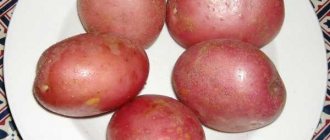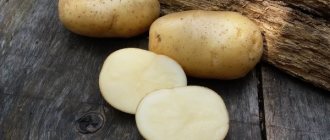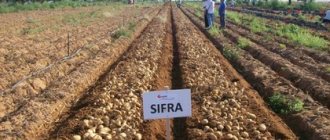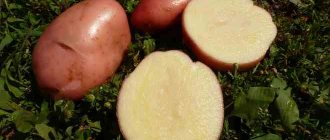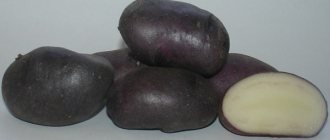Description of the potato variety Bryansk delicacy
The potato variety is intended for cultivation both on an industrial scale and in private farms. It has become popular due to its taste, shelf life, and good transportation.
The big advantage is that the seed material does not suffer from degeneration.
Origin story
The variety was bred in the early 2000s by Russian breeders. Then entered into the State Register. It was specially created for cultivation in the Central regions, in warm and temperate climates. However, in other regions it can be successfully grown.
Characteristics of tubers of the Bryansk delicacy variety
Tubers of this variety have the following features:
- size 70-130 g;
- oval in shape, smooth skin, yellowish in color;
- the eyes are small and sharp;
- yellow flesh;
- amount of starch - 15.5-17.7%.
The bush grows to medium size. The tops are spreading, thick and green. The leaves are dark green. The flowers are white, small, and quickly fade. The number of small, unmarketable fruits is small.
Exotic:
Potato variety Gourmet
Productivity of the Bryansk delicacy variety
The variety is liked by summer residents due to its high yield. With proper agricultural technology, one hectare can produce about 200 kg of crop. Up to 15 tubers are collected from each bush.
Potato ripening period and yield
The variety is classified as mid-early ripening. Bryansk delicacy potatoes ripen in 70-80 days, that is, a little less than 3 months. Harvest can already be done in mid-August.
Disease resistance
Another advantage of this species is its high resistance to various diseases and pests. The variety is resistant to cancer, striped mosaic, and leaf curl. Potatoes are not susceptible to nematode attacks.
But the Bryansk delicacy is affected by scab, rhizoctonia, fomoz, late blight of tops and late blight of tubers.
Black scab or Rhizoctoniasis
For which regions is it best suited?
The variety was developed for cultivation in regions of the middle zone, where winters are relatively mild and summers are long. The variety also does well in the southern regions.
In the northern regions - in the Urals and Siberia, it does not have time to ripen.
Advantages and disadvantages
Like any crop, Bryansk delicacy potatoes have pros and cons. Based on this list, gardeners prefer to grow the variety on their own plots.
Early development
Requests constant hilling
Good yield criterion
Admires late blight of tops and tubers, Phoma, tuber overgrowth
Resistant to cancer, severe forms of viral diseases, cyst nematode, rhizoctonia, scab, leaf curl and banded mosaic
Good yield criterion
High transportability and keeping quality
Ability of potatoes for industrial planting and processing
High marketability of potatoes - up to 97%
Good taste and nutritional quality
Seed material is not susceptible to degeneration
In a region with warm, long summers, it is possible to grow 2 crops during the season.
There are practically no downsides to the Bryansk Delicacy, but there is a long list of good qualities.
It is recommended to plant the potato variety with tubers, and only whole ones. Planting with seeds or halves is not recommended. In the first option, only breeders can cope with this method; in the other, the potato yield will be significantly reduced. The characteristic of the variety is that if you plant separated halves, they can rot even before germination. Very small Bryansk Delicacy potatoes are also not used - they will not produce a great harvest. Before planting, the tubers undergo pre-planting preparation:
- They're sorting through. Attention is paid to suspected signs of disease or pest damage, damage from mechanical factors, and signs of rot. Very small specimens are laid. It is acceptable to leave potatoes weighing about 90 g for planting.
- They germinate. A month before the appointed time for planting potatoes, the seed material is spread in boxes or on a flat surface in one layer. The room should be bright and warm. The tubers are lightly moistened with water from a sprinkler so that the buds hatch. When sprouts appear, make sure that they do not outgrow. A length of 1 cm is the most ideal.
The soil is loosened in advance, the remains of vegetation are selected, in which pathogenic microorganisms can easily form. In the ground for 1 sq. m add mature humus (3 buckets), wood ash (0.5 l), superphosphate (40 g).
The holes are placed in rows according to a pattern of 35 cm x 65 cm, where the first number is the distance between the potatoes, the second between the rows.
To accelerate the germination of seed material and eliminate the occurrence of diseases, it is treated with a growth stimulator and sprayed with a fungicide.
The tubers are placed in the holes and covered with a layer of soil. If you put a layer of wood chips between the rows, this will protect the potato plantings from rapid evaporation of moisture.
How to get rid of clover from your lawn in 2021
Firsthand about planting potatoes:
The originator has not laid down any special care requirements for the potato variety. It is important to provide the tubers with soil with a loose and light structure, plant in a timely manner (complete soil warming) and comply with standard agricultural technology requirements:
- watering;
- weeding, loosening and hilling;
- moderate feeding.
Water the Bryansk Delicacy potatoes sparingly. The frequency of watering depends on the weather and the stage of plant development. At the moment the buds appear and before the tops stop growing, water the potatoes first. At this time, the crop is being planted and the moisture deficit will be reflected in its quantity.
Loosening is also called dry watering.
If you grow the Bryansk Delicacy variety in a region where it is considered zoned, then loosening replaces most of the watering. And in years with wet summers, it is necessary to switch only to loosening.
Weeding is also the main activity for potato varieties. Weeds are able to absorb large amounts of moisture and nutrients from the soil, depriving the tubers of valuable elements. Weeds are also constantly a breeding ground for infections.
Hilling and feeding
Hill up the Bryansk delicacy potatoes 2 times. The first, when the tops reach a height of 15 cm, the second before flowering - 2 weeks after the first.
Depending on the growth rate of the variety and atmospheric conditions, the number of hillings can be increased up to four times. Hilling improves the growth of tops, protects potatoes from permissible frosts, and reduces the number of weedings.
Potatoes respond well to fertilizing. It is better to feed the Bryansk Delicacy variety with various types of fertilizers, alternating organic matter with mineral compounds.
Of the organic-based fertilizers, it is most advisable to take bird droppings with wood ash (2:1). An infusion of bird droppings is prepared, then diluted with water and mixed with ash. Mineral fertilizers include urea, ammonium nitrate or complex fertilizers. Time to fertilize potatoes:
- after germination;
- at the moment of budding;
- in the flowering phase.
Both root and foliar types of feeding work excellently for potato varieties.
Advantages and disadvantages
Among the advantages of the variety are:
- all tubers ripen together in a short time;
- excellent taste;
- good transportation and storage qualities;
- attractive presentation;
- suitability for industrial processing;
- the pulp does not darken after cooking;
- versatility of use;
- high resistance to many diseases;
- unpretentiousness of agricultural technology.
There are no significant disadvantages, except for susceptibility to scab, late blight, and nematode. In agricultural technology, many gardeners highlight the need for frequent hilling among the negative aspects.
Thus, the variety is attractive in appearance, taste, simple agricultural technology and versatility of use.
Peculiarities
The mid-early potato variety Bryansk Delicatessen has excellent taste. The ripening period for root crops is a little more than two months. Depending on the growing climate and soil quality, you can harvest from 160 to 300 centners of crop per hectare.
Potatoes can be stored for a long time, they are practically not damaged during transportation.
Potato bushes are spreading and medium in size. Their characteristic feature is the presence of a large amount of foliage and tops. The dark green large leaves are slightly wavy at the ends and cut with yellowish veins.
We invite you to familiarize yourself with potato varieties that have different ripening periods:
| Late ripening | Early ripening | Very early | Mid-late | Mid-early |
| Nikulinsky | Borovichok | Forty days | Crane | Yanka |
| Cardinal | Elmundo | Karatop | Sorcerer | Giant |
| Rocco | Felox | Riviera | Mozart | Tuscany |
| Kiwi | Bellarosa | Zhukovsky early | Grenada | Purple Haze |
| Ivan da Marya | Natasha | Farmer | Melody | Openwork |
| Picasso | Ariel | Minerva | Margarita | Santana |
| Asterix | Queen Anne | Veneta | Ramona | Desiree |
| Slav | Arosa | Kiranda | Dolphin | Lady Claire |
Varietal potatoes do not bloom for long - the small white flowers quickly fall off. Bryansk Delicacy has a powerful root system: about 15 large tubers are formed under the bush.
Potatoes do not get soft during cooking and do not darken after peeling. The variety has a pleasant taste.
REFERENCE: Almost all Bryansk Delicacy tubers are marketable - small and non-standard tubers are found in minimal quantities.
You can prepare a variety of dishes from the Bryansk delicacy. It's great for:
- Cooking;
- Frying;
- Stuffings;
- Baking.
Due to the high starch content, varietal potatoes are subject to industrial processing - crispy chips are obtained from them.
Planting potato varieties Bryansk delicacy
There is no difficulty in growing the Bryansk delicacy. The main thing is to follow the usual rules of agricultural technology to get a good harvest.
Preparing for landing
It is advisable to prepare the soil for planting in the fall. Apply potash and phosphorus fertilizers. If the soils are too acidic, they must be neutralized. Add lime or ash. Also in the fall, scatter manure throughout the future planting area, which will rot over the winter and reach a state where the plant can consume it.
Superphosphates and rotted humus are suitable as fertilizers.
At the end of winter, sort out the planting material. The Bryansk delicacy needs to be planted with whole tubers.
Select large, whole ones, with hatched eyes. It is not worth planting in halves, as they can simply rot in the ground. The optimal size is considered to be 90 g. Tubers should not be affected by diseases and pests. Start germination a month before planting. Place the fruits on the floor, on paper or wooden boards. The room should be bright and warm. The sprouts should grow no more than 1 cm, otherwise they may break when planted. There is even more information in the article on preparing potatoes for planting.
Soil requirements
The optimal soils for growing the Bryansk delicacy are light sandy loam soils with a fertile layer of chernozem.
When the snow melts and the soil warms up to the full extent of a shovel, begin preparing the ground for planting. Remove weeds, loosen the soil; if you didn’t dig it before winter, you need to dig it up in the spring.
Apply for each sq. m 3 buckets of humus or rotted manure, half a bucket of wood ash, superphosphates.
Dates, scheme and rules of planting
You can plant when the soil is sufficiently loose and warm. The average temperature should be +7-10 degrees. Typically, planting begins in late April-early May, depending on the weather conditions and climate of the region.
Plant one tuber per hole. The distance between bushes should be 30-40 cm, between rows 50-70 cm, so that you can walk freely and care for the plants. See what methods of planting potatoes gardeners use to increase yield.
Landing rules
Bryansk delicacy potatoes begin to be planted in the first ten days of May, when the soil warms up to 8–10 °C (you can check by burying a thermometer in the soil to a depth of 10 cm and holding it for 15 minutes). There are no special requirements for the planting site - it must be lighted and dry. Soil type – sandy loam or loamy, reaction neutral or slightly acidic.
Before planting, the soil begins to be prepared in the fall or in April. To do this, the soil is dug up and fertilized with humus or compost (3–7 kg per 1 m2). Instead, you can apply a complex fertilizer, for example, azofoska, in an amount of 30–40 g per 1 m2.
The Bryansk delicacy potato tubers begin to be prepared 3–4 weeks in advance. They are sorted through, dried and damaged ones are discarded. Then they are laid out in several layers on the floor or in wooden boxes, left in the light in a cool room at a temperature of 12–15 °C. Turn and spray periodically. A few hours before planting, they are treated with Bordeaux mixture, Fitosporin or Hom.
Bryansk delicacy potatoes can be planted as whole or cut tubers. Sequencing:
- Mark furrows at a distance of 70 cm (in the north-south direction).
- Tubers are planted to a depth of 10 cm. If the soil is heavy, clayey - 5–7 cm.
- Leave a distance of 35 cm between the holes in a row.
- Add a pinch of ash to each hole and cover with earth.
- Mulch the rows with straw or sawdust.
Caring for Bryansk delicacy
Gardeners like the Bryansk delicacy variety for its ease of care. The standard set includes watering, weeding, loosening and fertilizing. If all procedures are carried out on time, the plant will be pleased with a good harvest. Special requirements, the main thing is that the soil is moderately moist and loose, nutritious.
Watering
Irrigation is part of standard care. Potatoes love moderately moist soil, without overwatering. Organize watering in the amount required depending on climatic and weather conditions. If it is dry and hot, then increase the amount of watering. It is most important to provide sufficient water during flowering and bud set. Moisture deficiency affects the number of tubers on the bush.
If there is sufficient rainfall, you can get by by loosening the soil. Timely weeding will help preserve moisture in the soil; besides, weeds also take away nutrients.
Fertilizing variety
Potatoes respond positively to fertilizing. Carry them out three times a season: during seedling growth, flowering and after flowering, when tubers are forming.
To do this, use rotted manure, humus, a solution of bird droppings and ash. You can also apply potassium fertilizers according to the instructions. You can learn even more about feeding potatoes in this article.
Hilling
Hill up the Bryansk delicacy potatoes twice:
- when the tops grow 15-20 cm in height;
- before flowering begins or a couple of weeks after the first procedure.
Hilling also helps to restrain the growth of the aboveground part of the potato. It also protects root crops from frost. Therefore, if necessary, you can carry out a couple more hillings during the season. Find out more about the rules for hilling potatoes.
Features of cultivation
Agricultural technology has several features:
- Bryansk delicacy potatoes require regular watering during drought - otherwise the tubers may become deformed. During the hot period, it is moistened at least once a week, pouring a bucket onto 2-3 bushes.
- Hilling - at least three times per season (with an interval of 14 days).
- Feeding – 3 times: after emergence, during the formation of buds and at the flowering stage. Fertilizers (urea, complex, bird droppings, ash) are applied both by root and foliar methods.
The first hilling is carried out when the potato tops grow by 15–20 cm
Harvesting
The first harvest can already be dug up 40-50 days after germination. However, such potatoes are not stored for a long time and are suitable for immediate consumption. Also be careful when digging up so as not to damage the other fruits on the bush. They will not heal, but will begin to rot, infecting the rest.
The main harvest occurs three months after germination. Choose dry weather so that the potatoes do not have to dry out longer and do not carry away the fertile layer of soil along with them. The potatoes are dug up and laid out on the ground or in bags to dry. To prevent root vegetables from turning green, the day should not be sunny. After harvesting, they sort through and remove damaged and diseased specimens.
Potatoes should be stored in a dark, well-ventilated area at a temperature of +3-5 degrees. Otherwise, it will begin to wither and sprout. You can see how to store the harvested potatoes here.
Origin
The Bryansk Delicacy variety was bred by Russian breeders. Included in the State Register of the Russian Federation in 2002. Zoned for the Central region, but can be grown in any areas with a temperate or warm climate.
It is possible to plant on industrial fields, breed in farms and private farms. Potatoes are suitable for sale or industrial processing. Root crops are well stored, seed material is not prone to degeneration .
Read more about storing potatoes in winter, in boxes, peeled, in the refrigerator, as well as about the timing in the detailed materials on our website.
Read also: Where and how to store garlic so that it doesn’t dry out in winter?
The photo shows Bryansk Delicacy potatoes:
Diseases and pests of the Bryansk delicacy potato variety
One of the advantages of the variety is resistance to many diseases. It has extremely low susceptibility to various diseases and pests. Due to the fact that the variety ripens early, it does not have time to become infected with late blight. And if there is an epidemic, then it is enough to treat with copper preparations. See how to recognize potato disease.
Late blight on potato leaves
The probability of being affected by diseases is as follows:
| Name of the disease | Incidence rate |
| golden potato nematode | rarely |
| potato cancer | high degree of stability |
| scab | average degree of damage |
| viruses | high degree of stability |
| phomosis | weak |
| Alternaria blight | average degree |
| rhizoctoniasis | average degree |
| late blight | average degree |
As for pests, the most famous and dangerous is the Colorado potato beetle. The plant can also be affected by wireworms. There is no need to use chemicals. It is better to use traditional methods. Which can be learned from the article on the fight against wireworms in a potato field.
Care
Proper care of seedlings will provide you with good productivity. The basic rules for caring for Bryansk Delicacy are as follows:
- Planting material should be planted after the soil has warmed up sufficiently;
- It is recommended to hill up the bushes several times a month;
- Regular weeding of potato beds;
- Feeding seedlings and adding mineral fertilizers to the soil;
- Moderate watering;
- Protection from pests - Colorado potato beetles, cutworms, mole crickets.
Before planting it is recommended:
- Dress the tubers;
- Dry the planting material;
- Treat potatoes with growth stimulants.
IMPORTANT: You need to plant healthy medium-sized tubers that are not affected by diseases or pests.
Before planting prepared potatoes, you need to loosen the soil well. It is recommended to add wood ash, superphosphate or humus to the soil.
Be sure to plant the tubers at a distance of at least 30 cm from each other. The row spacing should be approximately 60-70 cm.
The bushes can be mulched with mowed grass - this will maintain moisture in the soil and protect the seedlings from pests.
Reviews about the variety
Alexander, Voronezh
I like the variety. This is not the first year I have been growing it. The agricultural technology is simple, sometimes it’s enough just to loosen and hill up, you don’t even need to water. The tubers turn out large and tasty. I make everything: purees, soups, baked goods.
Vasily, Belgorod
We grow potatoes in the field. We use mechanized growing methods: planting, harvesting and processing. I really like that even damaged tubers do not spoil, but lie there until we prepare something from them.
Gennady, Ryazan
The variety is good. It is not affected by diseases, and the Colorado potato beetle can be controlled. The potatoes taste excellent. Even from a small plot the harvest is decent.
Damage by diseases and pests
In terms of disease resistance, the Bryansk Delicacy potato variety has very good indicators. The likelihood of being affected by various diseases is very low. Due to early ripening, it is not affected by late blight. If there is an epidemic in the area where potatoes are planted, the plantings should be treated with special copper-containing compounds.
Probability of disease
Preventive measures include regular weed removal, loosening the soil and mulching with cut grass or straw.
Important! For potatoes, the real danger is the invasion of the Colorado potato beetle. Today there are many ways and recipes to combat it, so choosing the most suitable option is not difficult. You can make a remedy for the fight according to a folk recipe, or you can buy a ready-made drug.
The greatest danger to potatoes is the wireworm. This is the larva of a click beetle, from which correct crop rotation will save you. Potatoes should not be planted in one place for more than three years. After harvesting, it is recommended to sow the field with oilseed radish or phacelia.

